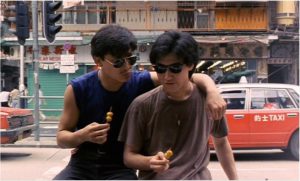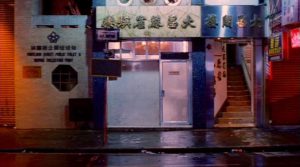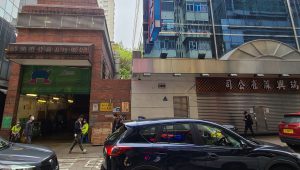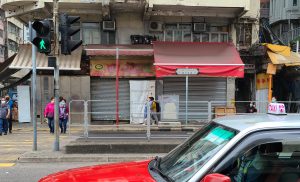AS TEARS GO BY, DIR. KAR-WAI WONG (1988)
Yau Ma Tei Theatre & Portland St., Kowloon District, Hong Kong

Wah, the head of Fly, is persuading Fly to give up dangerous actions and sell fish balls for living. Fly’s street stall is located at Yau Ma Tei Theatre at the Reclamation Street. Scenes from the In-gear Film’s As Tears Go By 1988, directed by Kar-wai Wong.
As Tears Go By (Chinese Title: Mongkok Carmen) is the debut film of Kar-wai Wong’s as a director, who is now putatively a fame-winning director by his hetrodox methods of storytelling and filming techniques. As Tears Go By, however, still possesses many typical features of Hong Kong ganster films, despite some personal peculiarities of Wong. Mongkok and Yau Ma Tei, located along the mainbone of Kowloon — Nathan Road, is the main stage of Wah (阿華, played by Andy Lau) and Fly (烏蠅, played by Jacky Cheung), the two protagonists in the film. Although there are also some scenes shot in Kowloon City at the east of Mongkok, the former one’s landscape has fundamentally changed, with the removal of Kowloon Wall City as a symbol.
Wah was a retire-intended mob, and Fly was his troublesome “minion”, always making quarrels and conflicts with others. Fly wanted to win “face” among the crowd. He bet money in gamblings, borrowing money, all for satisfying his self-respect. His method for getting self-identity is not wise from Wah’s views, and eventually he owed a large debt to the gang Tony (Alex Man). Wah, chose to help Fly, was finally inevitable to be involved into the severe conflicts between Fly and Tony, and they paid huge costs at the end.
Many violence scenes were shot in teacafes and Majhong houses. After nearly forty years, it is never easy to find the same Majhong house’s place. While Portland Street, located in the heart of Mongkok, is one of the place shot, and available to located thanks to the rubbish collection station. Great modern shopping mall Langham Place (朗豪坊) is now built on Portland Street. Only from some Majhong houses and nightclubs remained could we know that Portland St. used to be a place with all kinds of pleasure. As Benjamin said or even far more than he assumed, in the era of mechanic reproduction, a place is losing its aura very quickly, even people could not have time to regard something as a monument and learn how to appreciate it. 1



Left: The place where Fly attacked Tony’s car and got beated. Fly was severely hurt and Wah was called to rescue him. Scenes from the In-gear Film’s As Tears Go By 1988, directed by Kar-wai Wong. Middle: The same place at Portland St., Mongkok, where the rubbish collection station is not moved. A Mahjong house is still operated besides the rubbish station although the building and the name of Mahjong house is not the same. Right: Langham Place located closely on the street.
Although violence is the main-stem of this film, some scenes we could now call “Kar-wai Wong style” appeared in tiny intervals of major violence scenes. One of them is the plot where Wah encouraged Fly’s to work hard on selling fishballs for building a brighter new life. Definitely, Fly loafed his job, but when Wah came, Fly hurrily pretended to work hard. A sense of brotherhood and emotional ties between Wah and Fly is built in this scene, as well as a metaphor for their tragedic end when they talked about future. The street and the theatre, are made as the place where events occured. People may recall this scene when they pass by the Yau Ma Tei Theatre. A new meaning is built through the story and partially redefined the space as also mentioned by de Certeau.2


Left: Same as the opening. Scenes from the In-gear Film’s As Tears Go By 1988, directed by Kar-wai Wong. Right: View towards the other side of Waterloo Rd. from Yau Ma Tei Theatre. Shot from the gate of the theatre. The small entry on the right is a useful clue.
— Yalun Li, 3035532777
References:
1 Benjamin, Walter. 2008. The Work of Art in the Age of Mechanical Reproduction. Translated by J. A. Underwood. Penguin Great Ideas. Harlow, England: Penguin Books.
2 Certeau, Michel de. 2011. The Practice of Everyday Life. Translated by Steven F. Rendall. 3rd ed. Berkerley: University of California Press.
Your effort in searching for the right site is appreciated. You also noticed the changes and made appropriate comparisons. It is wished that you elaborate your point on ‘aura’. How does the mechanical reproduction killed/ saved the aura of Portland Street? How does that have to do with ‘disappearance’? You might also look into the Mahjong house and teahouse for interior scenes and comparisons.
Actually, I wrote some elaborations but it seems an excess of the word count…
What I meant when I mentioned Benjamin is that every thing was changing so fast that hardly anything could persist existing for a long time, enough to be recognized as something worth appreciating, or like in Abbas’ discourse, worth preserving. People seldom have time stand still, and look the buildings, stare or gaze at the objects around. It’s changing so fast and rarely something’s disappearance will keep drawing people’s memory out after several years.
For the inside environment of majhong houses, you are right. I should have a visit there lol.